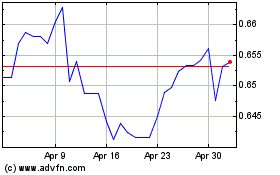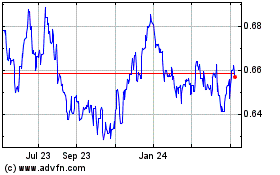U.S. Dollar Climbs On Fed Rate Hike Hopes
August 29 2016 - 11:13PM
RTTF2
The U.S. dollar drifted higher against its major counterparts in
pre-European trading on Tuesday, following the release of in-line
personal income and spending data in July, which strengthened odds
for an increase in the federal funds rate as soon as next
month.
A report from the Commerce Department showed that income and
spending rose in line with economist estimates in the month of
July. The personal income climbed by 0.4 percent in July after
rising by 0.3 percent in June. The increase in income matched
economist estimates.
The personal spending rose by 0.3 percent in July following a
0.5 percent increase in June. The spending growth also met
expectations.
Investors now focus on the all-important U.S. jobs report due at
the end of the week for clarity on the likely timing of the next
increase in the Fed funds rate.
It is believed that the nonfarm payroll report could have a
significant impact on the interest rate outlook going into the next
Federal Reserve meeting in September.
The greenback has been trading in a positive territory on
Monday, buoyed by the Federal Reserve Chair Janet Yellen's remarks
that an interest rate hike this year was still on the table.
The greenback rose 0.2 percent against the pound, 0.1 percent
against the yen, 0.4 percent against the euro and 0.02 percent
against the Swiss franc for the day.
The greenback appreciated to 0.9812 against the Swiss franc, its
strongest since August 10. The greenback is likely to find
resistance around the 1.00 mark. At yesterday's close, the pair was
worth 0.9781.
The greenback, having fallen to a 4-day low of 101.75 against
the yen at 8:00 pm ET, rebounded to 102.31. If the greenback-yen
pair extends rise, 104.00 is possibly seen as its next resistance
level.
Data from the Ministry of Internal Affairs and Communications
showed that Japan's retail sales fell 0.2 percent on year in
July.
That beat forecasts for a decline of 0.9 percent following the
upwardly revised 1.3 percent contraction in June
Reversing from an early low of 1.1192 against the euro, the
greenback edged up to 1.1164. The next possible resistance for the
greenback may be located around the 1.10 region.
Data from Destatis showed that Germany's import prices continued
to fall in July but the pace of decline slowed for the third
straight month.
Import prices decreased 3.8 percent year-on-year in July, slower
than the 4.6 percent decline seen in June and the expected fall of
4 percent.
The greenback advanced to 1.3064 against the pound, off its
previous low of 1.3119. On the upside, the greenback may test
resistance around the 1.28 area.
The greenback reversed from its early lows of 1.3009 against the
loonie and 0.7580 against the aussie, edging up to 1.3040 and
0.7554, respectively. The greenback is poised to test resistance
around 1.32 against the loonie and 0.74 against the aussie.
The greenback remained higher against the kiwi, trading at
0.7243, off its early 4-day low of 0.7265. Continuation of the
greenback's uptrend may see it challenging resistance around the
0.71 mark.
Data from Statistics New Zealand showed that New Zealand's
building permits tumbled a seasonally adjusted 10.5 percent on
month in July, coming in at 2,811.
That follows the upwardly revised 21.9 percent spike in
June.
Looking ahead, U.K. mortgage approvals for July and Eurozone
economic confidence index for August are slated for release in the
European session.
In the New York session, German flash CPI data for August,
Canada industrial product and raw materials price indexes for July,
U.S. S&P/Case-Shiller home price index for June and U.S.
consumer confidence index for August are set to be published.
AUD vs US Dollar (FX:AUDUSD)
Forex Chart
From Aug 2024 to Sep 2024

AUD vs US Dollar (FX:AUDUSD)
Forex Chart
From Sep 2023 to Sep 2024
